Cinema Cameras
To achieve the very best in cinema imaging traditional film cameras are still the best to use. Below are some of the fully operational cinema cameras used by owyheesound. Admittedly these cameras are a bit more difficult to use than modern digital video cameras but they can produce stunning results that even high definition cameras can not yet match in color depth, latitude response, and resolution.
There are several disadvantages to using film instead of video. The most notable is technical operation issues. Loading, unloading and making proper exposures can be fairly difficult. Nearly all cinema camera do not have their own light meter. Exposure must be calculated with a separate meter. While this is difficult it can yield the very best results, far superior to an on board light meter. Some of the cameras below have been retrofitted with modern digital video assist, and other special synchronization devices to make them more useful in the digital age.
The most talked about disadvantage is the cost of the film. The cost of 100 ft of 16 mm color negative film plus developing is about $55.00. A print for said negative is about $28.00. The run time of 100 ft of 16 mm film running at 24 frames per second is 2min 46secs.
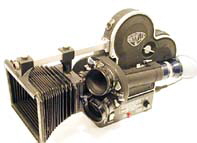 Arriflex-S
Arriflex-S
The Arriflex-S is a vary popular camera because of it's very steady film movement. This movement helps to create very high quality professional images. The camera can operate as a small 100 ft load hand held unit or as a tripod mounted 400 ft load camera. There are a wide range of lenses available for this camera as well as crystal sync motors.
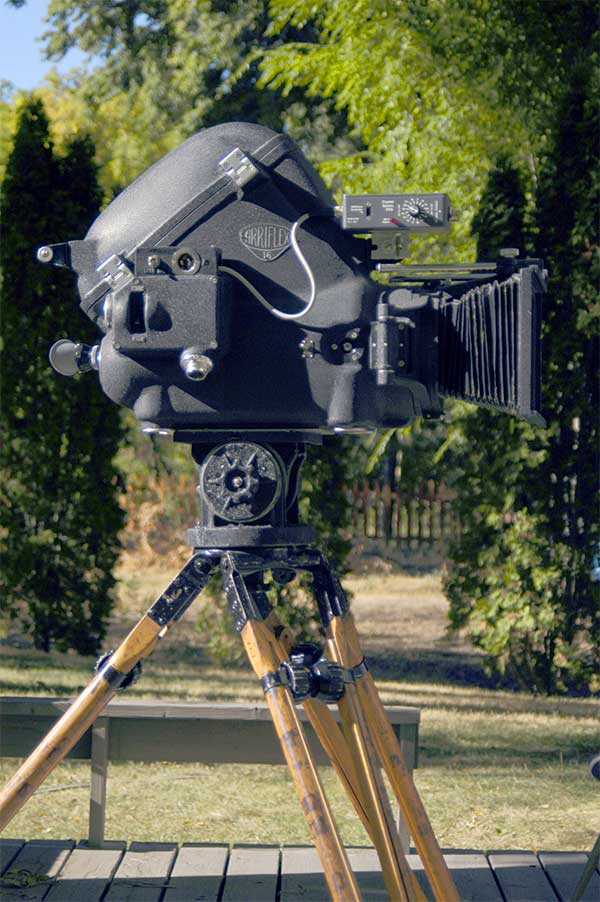 Arriflex-S Blimp
Arriflex-S Blimp
The Arriflex-S can be used as a silent studio camera when housed in a sound proofing blimp. Note that blimp is very large to accommodate the camera, the 400 ft magazine and zoom lens. For more details about the Arriflex-16 Blimp click here.
Auricon Pro-600
This was historically used as a news camera in the 50s and 60s and was only replaced as video cameras became viable in the 70s. This camera is a sync camera where 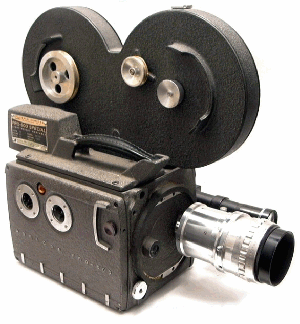 the motor is synchronized to the 60hz 120VAC that is supplied to it. It can run of house current, but synching it to other cameras and recorders is easily done with a power inverter. This camera has two methods for recording sound on film. The original method was to record an optical sound track on one edge of the film. This was done by converting the audio signal into an light signal by means of a device not dissimilar to an oscilligraph. The other method is to record sound onto a special film that has a magnetic stripe down one side. This method produced better quality sound than the optical recording but the special striped film is no longer readily produced. Click here to get more details about the Auricon pro-600
the motor is synchronized to the 60hz 120VAC that is supplied to it. It can run of house current, but synching it to other cameras and recorders is easily done with a power inverter. This camera has two methods for recording sound on film. The original method was to record an optical sound track on one edge of the film. This was done by converting the audio signal into an light signal by means of a device not dissimilar to an oscilligraph. The other method is to record sound onto a special film that has a magnetic stripe down one side. This method produced better quality sound than the optical recording but the special striped film is no longer readily produced. Click here to get more details about the Auricon pro-600
Arriflex-M/B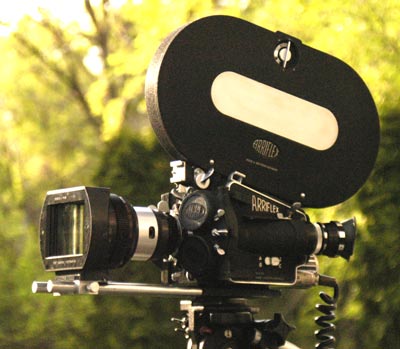
Shown here fitted with a lens rail and a Lomo 2x anamorphic lens adapter in front of a 25 mm prime. For more details about the Arriflex-M click here. Anamorphic lenses are one method used to create wide screen images. They work by squeezing an image from a wide lens to fit a normal format film frame. Upon projection the image is stretched back out to produce a very wide image, in this case twice as wide as the camera would normally produce. Click here to find out more about anamorphic lenses
Arriflex 35 II 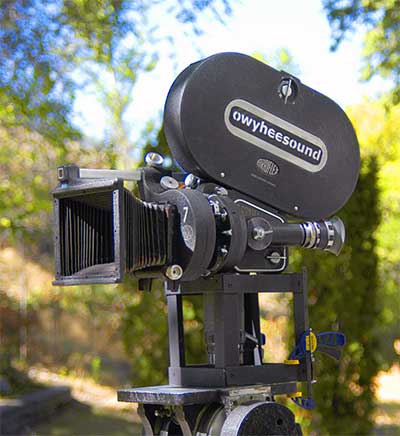
This 35 mm MOS camera is one of the most popular cameras of it's kind and has enjoyed use in professional cinema work for over 50 years. Pictured is a IIB body and a IIC door and viewer, with a Pilotone output modification, and a 400 ft magazine. Click here for more details.
Arri 120S Blimp
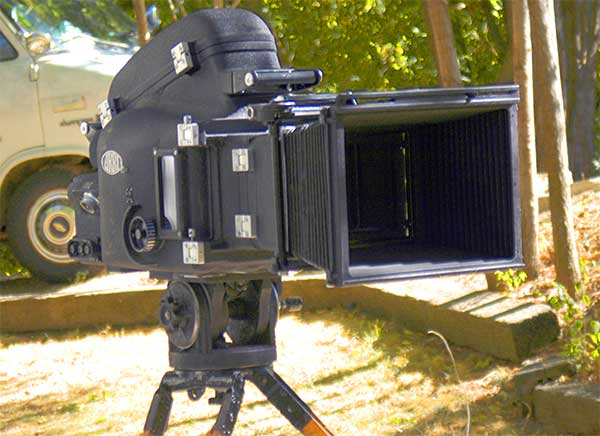 Like the 16 mm cameras that require a blimp to be used for sound studio recording the Array Is also have a blimp they can be placed into for sound stage use. Click here for more info on the Array 120S blimp.
Like the 16 mm cameras that require a blimp to be used for sound studio recording the Array Is also have a blimp they can be placed into for sound stage use. Click here for more info on the Array 120S blimp.
Mitchell 35 mm BNCR
A true Hollywood Classic, this 35 mm studio camera was, at one time, the  number one workhorse of movie industry in the United States. Mitchell used to make the claim that 85% of all the films made world wide were made using their cameras. It wasn't until the 1970s when the Panavision camera replaced the Mitchell as the camera of highest recognition. Incidentally, the first Panavision cameras were merely converted Mitchell cameras. For more details click here.
number one workhorse of movie industry in the United States. Mitchell used to make the claim that 85% of all the films made world wide were made using their cameras. It wasn't until the 1970s when the Panavision camera replaced the Mitchell as the camera of highest recognition. Incidentally, the first Panavision cameras were merely converted Mitchell cameras. For more details click here.
Pallaird Bolex H16 Standard
This is one of the most popular and well known 16 mm cinema cameras. 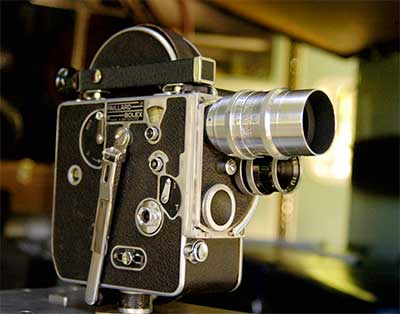 This camera has a 100' internal film capacity, parallel viewing with easy to use parallax adjustment, ground glass fine focus adjustment, and good stop motion ability. While the later reflex or "REX" version is more desirable for live action shooting this old parallel view finder type is still one of the best cameras for animation because of it's light weight shutter. For more details click here.
This camera has a 100' internal film capacity, parallel viewing with easy to use parallax adjustment, ground glass fine focus adjustment, and good stop motion ability. While the later reflex or "REX" version is more desirable for live action shooting this old parallel view finder type is still one of the best cameras for animation because of it's light weight shutter. For more details click here.
The Krasnogork K-3
This is a fun little 16 mm camera. If you want to try out 16 mm film with out a large cash outlay this is the 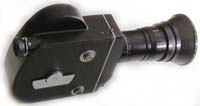 best camera to consider. It has a very usable zoom lens, an onboard light meter, and is spring powered so there is no need of a cumbersome batter pack. With proper consideration this camera can be used to produce great prints that can be projected on a 16 mm projector.
best camera to consider. It has a very usable zoom lens, an onboard light meter, and is spring powered so there is no need of a cumbersome batter pack. With proper consideration this camera can be used to produce great prints that can be projected on a 16 mm projector.
Wollensack Fastax 16 mm
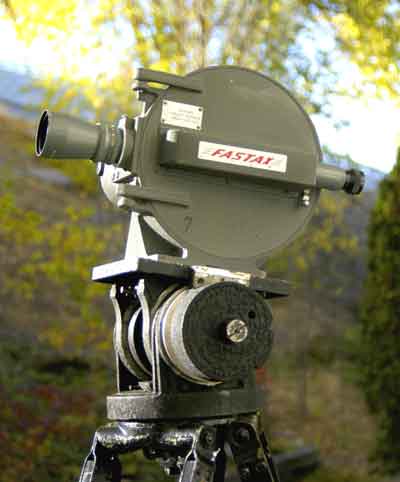 This is a ultra high speed camera capable of shooting up to 5600 frames per second. Primarily used for scientific and industrial applications this camera can also be used for cinema special effects.
This is a ultra high speed camera capable of shooting up to 5600 frames per second. Primarily used for scientific and industrial applications this camera can also be used for cinema special effects.
RedLake Fastax 2
Mitchell Monitor 16 high speed camera
Mitchell "16" Blimp
Mitchell's 16 mm pin registered camera can be blimped to run as a 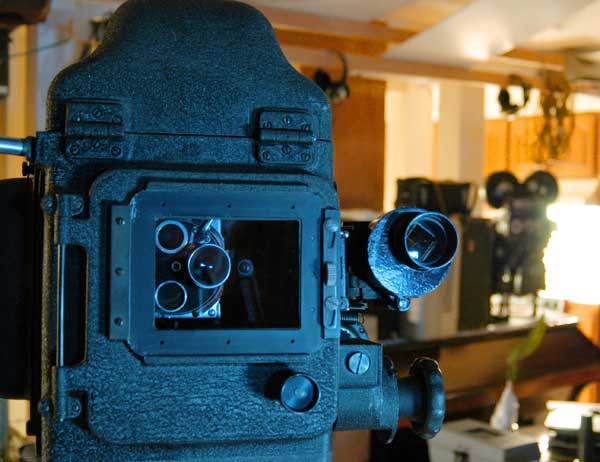 studio camera. The blimp can also be used to silence an array of other small 16 mm cameras like a Bolex H16, a Krasnogork K-3, Arriflex 16 mm cameras, and could even be used to completely silence Auricon, and CP-16 cameras with only minor modifications.
studio camera. The blimp can also be used to silence an array of other small 16 mm cameras like a Bolex H16, a Krasnogork K-3, Arriflex 16 mm cameras, and could even be used to completely silence Auricon, and CP-16 cameras with only minor modifications.

 Arriflex-S
Arriflex-S


 Like the 16 mm cameras that require a blimp to be used for sound studio recording the Array Is also have a blimp they can be placed into for sound stage use.
Like the 16 mm cameras that require a blimp to be used for sound studio recording the Array Is also have a blimp they can be placed into for sound stage use.  number one workhorse of movie industry in the United States. Mitchell used to make the claim that 85% of all the films made world wide were made using their cameras. It wasn't until the 1970s when the Panavision camera replaced the Mitchell as the camera of highest recognition. Incidentally, the first Panavision cameras were merely converted Mitchell cameras. For more details
number one workhorse of movie industry in the United States. Mitchell used to make the claim that 85% of all the films made world wide were made using their cameras. It wasn't until the 1970s when the Panavision camera replaced the Mitchell as the camera of highest recognition. Incidentally, the first Panavision cameras were merely converted Mitchell cameras. For more details  This camera has a 100' internal film capacity, parallel viewing with easy to use parallax adjustment, ground glass fine focus adjustment, and good stop motion ability. While the later reflex or "REX" version is more desirable for live action shooting this old parallel view finder type is still one of the best cameras for animation because of it's light weight shutter. For more details
This camera has a 100' internal film capacity, parallel viewing with easy to use parallax adjustment, ground glass fine focus adjustment, and good stop motion ability. While the later reflex or "REX" version is more desirable for live action shooting this old parallel view finder type is still one of the best cameras for animation because of it's light weight shutter. For more details  best camera to consider. It has a very usable zoom lens, an onboard light meter, and is spring powered so there is no need of a cumbersome batter pack. With proper consideration this camera can be used to produce great prints that can be projected on a 16 mm projector.
best camera to consider. It has a very usable zoom lens, an onboard light meter, and is spring powered so there is no need of a cumbersome batter pack. With proper consideration this camera can be used to produce great prints that can be projected on a 16 mm projector. This is a ultra high speed camera capable of shooting up to 5600 frames per second. Primarily used for scientific and industrial applications this camera can also be used for cinema special effects.
This is a ultra high speed camera capable of shooting up to 5600 frames per second. Primarily used for scientific and industrial applications this camera can also be used for cinema special effects. studio camera. The blimp can also be used to silence an array of other small 16 mm cameras like a Bolex H16, a Krasnogork K-3, Arriflex 16 mm cameras, and could even be used to completely silence Auricon, and CP-16 cameras with only minor modifications.
studio camera. The blimp can also be used to silence an array of other small 16 mm cameras like a Bolex H16, a Krasnogork K-3, Arriflex 16 mm cameras, and could even be used to completely silence Auricon, and CP-16 cameras with only minor modifications.